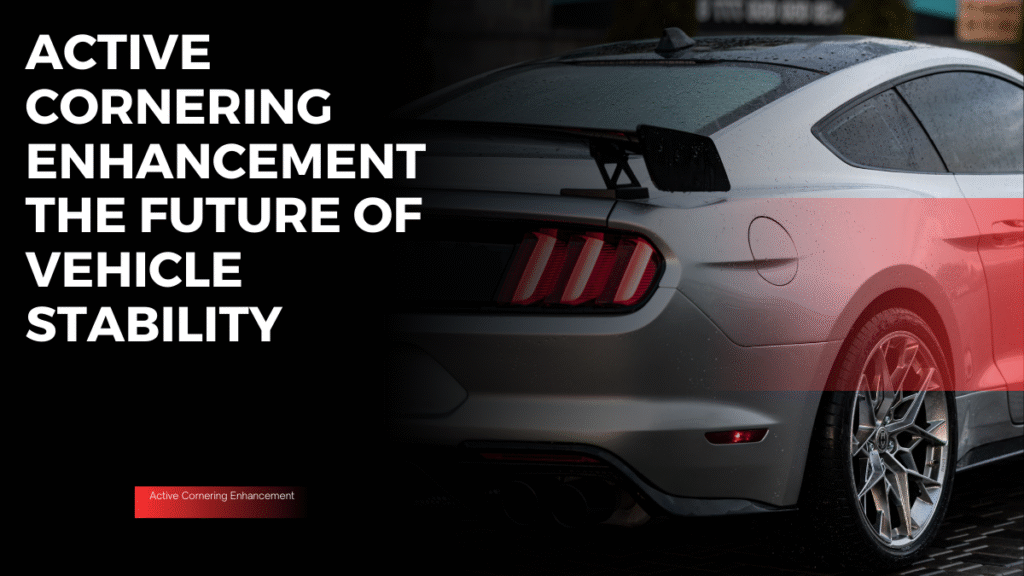Within the first few moments of driving on a curvy road, one thing becomes evident: cars are not just about speed but about control. Active Cornering Enhancement (ACE) is a system designed to solve this challenge. It improves vehicle stability during cornering by actively reducing body roll, ensuring a safer, smoother, and more confident driving experience. Unlike traditional suspension systems, ACE dynamically adjusts to driving conditions, making cars more agile while keeping passengers comfortable. For anyone curious about how modern vehicles achieve such balance between power and precision, understanding ACE is essential.
What is Active Cornering Enhancement?
Active Cornering Enhancement (ACE) is an advanced automotive technology developed to counteract excessive body roll when a vehicle turns. Body roll is the natural tilting of a vehicle’s body that happens during sharp turns due to centrifugal force. Traditional suspension systems rely heavily on passive stabilizer bars, which can only do so much. ACE, however, uses a hydraulic control system to dynamically manage how much the vehicle leans.
This means instead of waiting for body roll to occur, ACE predicts and prevents it by distributing pressure to different parts of the suspension. The result is a flatter, more stable ride, particularly noticeable on winding roads or when making sudden evasive maneuvers.
Why Does Cornering Matter So Much?
Driving isn’t just about going in a straight line. Roads bend, curve, and twist. In these moments, a vehicle’s ability to maintain stability is critical. Poor cornering control can cause:
- Loss of traction
- Reduced passenger comfort
- Increased rollover risks in tall vehicles like SUVs
- Slower response time in emergencies
Active Cornering Enhancement directly addresses these risks. It ensures drivers can maintain their intended path with minimal compromise in comfort or safety.
The Technology Behind Active Cornering Enhancement
At its heart, ACE relies on hydraulics and smart engineering. Unlike electronic stability systems that rely purely on sensors and braking intervention, ACE is mechanical-hydraulic. It places hydraulic actuators on both the front and rear suspension systems.
Here’s a simplified breakdown of its operation:
| Component | Function | Impact on Cornering |
|---|---|---|
| Hydraulic Actuators | Apply controlled pressure to suspension arms | Reduces body roll dynamically |
| Control Valves | Direct hydraulic flow between front and rear systems | Balances cornering forces |
| Suspension Arms | Work with actuators to adjust wheel position | Keeps tires in optimal contact with road |
| ECU (Electronic Control Unit) | Coordinates hydraulic actions | Ensures timing and precision |
The system is proactive rather than reactive. When the vehicle senses lateral forces during cornering, the ACE actuators apply counter-pressure, keeping the vehicle flat. This provides both handling benefits and passenger comfort.
How ACE Differs from Traditional Anti-Roll Bars
Most vehicles use anti-roll bars (sway bars) to connect left and right suspension systems. They reduce roll by resisting independent wheel movement. But anti-roll bars are passive—they only respond after the roll starts.
ACE, in contrast:
- Predicts and counters roll instantly
- Works independently at front and rear
- Does not compromise ride comfort on straight roads
- Adapts to road and driving style dynamically
The distinction lies in responsiveness. Where anti-roll bars are corrective, ACE is preventative.
The Origins of Active Cornering Enhancement
ACE was first popularized in the early 2000s by Land Rover, a brand known for balancing rugged off-road capability with on-road refinement. SUVs, by nature, have a higher center of gravity, making them prone to body roll. Land Rover recognized the need for a system that preserved comfort while improving agility.
Since then, the concept has influenced other automotive innovations, paving the way for integrated stability systems that blend hydraulics with electronics. Today, many luxury and performance brands are investing in similar technologies, though often under different names.
Benefits of Active Cornering Enhancement
The advantages of ACE stretch beyond cornering itself. They impact safety, driving pleasure, and long-term vehicle health.
1. Improved Handling
Drivers feel more connected to the road, with precise steering response. On winding roads, vehicles equipped with ACE stay flatter, making driving less fatiguing.
2. Enhanced Safety
By reducing roll, ACE lowers the risk of rollover accidents—particularly in taller vehicles like SUVs. Passengers remain secure, even during emergency lane changes.
3. Comfort Preservation
ACE decouples roll resistance when the vehicle is moving straight, so passengers don’t feel unnecessary stiffness. Comfort and stability coexist.
4. Off-Road Performance
For vehicles like Land Rovers, ACE improves both highway stability and rugged terrain control. The adaptability of hydraulics makes it ideal for mixed driving environments.
5. Tire Longevity
Because ACE ensures optimal tire-road contact, it reduces uneven wear, extending tire life.
Limitations and Challenges
No technology is flawless. ACE has its trade-offs:
- Complexity: Hydraulic systems are more complex and require specialized maintenance.
- Weight: Additional components add weight, impacting fuel efficiency.
- Cost: Systems like ACE are expensive to develop and repair, often reserved for premium vehicles.
- Electrification Shift: With the rise of electric vehicles, manufacturers must integrate such hydraulic systems with battery-driven platforms—posing new engineering challenges.
Despite these drawbacks, ACE remains a benchmark technology for stability enhancement.
How Active Cornering Enhancement Works in Real-World Driving
Let’s illustrate with scenarios:
- Sharp Mountain Curves: Without ACE, the SUV leans heavily, unsettling passengers. With ACE, the system counters lean, keeping the cabin level.
- Emergency Lane Change: ACE keeps the car flat, improving tire grip and directional stability.
- City Driving: When cruising straight, ACE disengages, allowing a comfortable ride without stiffness.
- Off-Roading: ACE adjusts hydraulically to uneven surfaces, preventing wheels from lifting unnecessarily.
Active Cornering Enhancement and the Future of Driving
As vehicles become smarter and electrified, ACE is evolving. Hydraulic systems may integrate with electric actuators in the future, offering even faster response and reduced energy consumption. The shift toward autonomous vehicles also means cornering stability systems like ACE will play a role in ensuring passengers remain comfortable while the car handles itself.
In addition, automakers are researching how to combine ACE with AI-driven predictive analytics. Imagine a car that not only reacts to a turn but anticipates it by reading road maps and driver habits.
Comparative Analysis: ACE vs. Other Stability Systems
| Technology | Mechanism | Strengths | Weaknesses |
|---|---|---|---|
| Anti-Roll Bars | Passive torsional bars | Simple, low-cost | Limited effectiveness |
| Electronic Stability Control (ESC) | Selective braking | Widely available, effective | Can feel intrusive |
| Magnetic Ride Control | Electromagnetic fluid shocks | Instant adaptability | High cost |
| Active Cornering Enhancement | Hydraulic actuators | Preventative, smooth, effective | Complex, heavy |
ACE stands out because it balances mechanical strength with predictive control.
The Consumer Perspective
From the driver’s seat, ACE feels intuitive. There’s no button to press, no mode to select. The system works silently in the background. Many drivers may not even realize it’s there until they experience a corner without it.
Car reviewers often highlight ACE as one of those invisible features that dramatically changes how a vehicle feels. It’s not flashy, but it’s foundational to driver confidence.
Environmental Considerations
With sustainability now central to automotive design, hydraulic systems like ACE face scrutiny. The oil-filled actuators require materials and maintenance that aren’t fully aligned with greener goals. Automakers are exploring electric actuators as replacements, offering similar stability benefits with fewer environmental drawbacks.
Looking Ahead: Potential Improvements
- Integration with EV Platforms: Lightweight electric actuators to replace hydraulics
- AI-Based Predictive Cornering: Systems that anticipate curves using GPS and driving data
- Modular Systems: Scalable ACE modules adaptable for small cars to heavy-duty trucks
- Reduced Cost: Bringing stability technologies to mid-range vehicles instead of limiting them to luxury models
Frequently Asked Questions
1. How does Active Cornering Enhancement improve safety?
It reduces body roll during cornering, lowering rollover risks and maintaining better tire contact for improved grip.
2. Is ACE the same as Electronic Stability Control (ESC)?
No. ESC uses braking to control skids, while ACE prevents roll through hydraulic suspension adjustments. They complement each other.
3. Does ACE require special maintenance?
Yes. Hydraulic systems require regular inspections to ensure actuators and fluids remain functional, though they are designed to last.
4. Is Active Cornering Enhancement available in all cars?
Currently, it is mostly offered in premium SUVs and off-road vehicles, though future versions may expand availability.
5. How does ACE affect fuel efficiency?
The added weight slightly reduces fuel economy, but the safety and stability benefits often outweigh this drawback.







